Although Indian civilisation is very ancient, its early history is still obscure, but we know that at least for four thousand years ago an advanced civilisation was present in the northern valley of the Indus. Excavations of two cities, Mohenjodaro and Harappa, have revealed to us some details, tantalisingly incomplete, of the material remains of the Indus Valley civilisation, including large public buildings, probably intended for religious purposes; however, this culture came to an abrupt end around 1,500 BCE. It was to be many centuries later, around 250 BCE, that the Emperor Asoka made Buddhism the state religion for most of the Indian sub-continent, and the next significant construction of religious buildings was undertaken. Asoka caused to be erected in many places tall stone pillars, some as high as fifty feet, crowned by a Buddhist symbol: the triple lions and the wheel of the law. These symbols from the pillar at Sarnath have been taken as the state emblems of modern India.
The earliest Indian temples that survive today are built no earlier than 400 CE, although some images of the jinas are claimed to date from the third century BCE (1992: personal communication at Valabhi and Nalanda). Temples are usually classified, on the basis of their architectural style, into two main groups. In the south the so-called 'Dravidian' style developed on different lines from the 'nagara' or 'Indo-Aryan' tradition of the north. A third style is also identified, described as the 'intermediate' style, or the 'Calukya' style, from the ruling dynasty, which flourished in the south from the eleventh century CE.
On broader architectural features, there is no major difference between the temples of the main branches of Hinduism, or between those of the Hindus and the Jains. In fact, the evolution of Indian culture, art and architecture is the mingling of many streams of culture living on the sub-continent. The distinctions become apparent only on examination of the images and other sculpture.
In its fully developed form, the temple is entered through a porch that leads into the main hall, the pavilion, and a more or less spacious pillared area where the faithful can assemble for worship. Sometimes there may be side wings giving a cruciform pattern. A vestibule (antaraala) will connect the hall with the sanctuary (vimaana) within which is the shrine containing the holy image (garbha griha). The sanctuary area is usually of considerable height with a pyramid or tall spire-shaped pinnacle (sikhara), which is the dominant feature externally. Often a perambulatory passageway allows the worshipper to walk around the garbha griha and the image within. The Indian temple is essentially the house of God: the image in the garbha griha (which is frequently a small dark cell) is the focal point, the raison d'être of the temple, its location clearly marked externally by the tall sikhara.
Whilst the architecture of the temple evolved over the centuries, it developed within the broad framework of the rules of architecture laid down in the ancient traditional Vastusastra, which formed the basic textbook for the architect and builder. The techniques of the Indian temple were uncomplicated: arches and domes were constructed from horizontal overlapping slabs of stone kept in place by the weight of those above, as distinct from the true arch with a keystone as found in European architecture.
Thus the Indian temple is weighty, solid and the grounded, not fashioned and soaring like the later Gothic cathedral in the West with precisely calculated stresses on its keystone arches and minimal columns and buttresses. The solidity of the Indian temple is concealed by its decoration, with its walls and columns, internal and external, often richly carved with breathtaking splendour.
The most noticeable difference between the northern and southern styles of temple architecture lies in the treatment of the sikhara. The north Indian tower commonly has the 'sugar-loaf' shaped, tapering with gentle convex upward curves to a rounded finial or capstone at its apex. Basically square in plan, such a tower can have smaller versions of the same shape surrounding it, giving a star-shaped plan and, where there are several levels of these smaller elements, producing an elegant curved cone with a vertical emphasis which leads the eye upwards. It has been suggested that the shape of this tower developed from an early canopy for an image, the framework of which was made by setting four bamboo rods vertically in the ground and then bending and tying them together at their apex. This derivation sounds fanciful but certainly the resultant form is very pleasing to the eye.
Over the main hall, the pavilion of the northern temple, the roof may be flattened or a pyramid, or may perhaps have a low dome. In some examples, two or three pyramid shaped roofs rise from the porch to the main hall and may lead the eye up to the towering pinnacle.
For the Dravidian style, the tower rests on a square base and is a pyramid in form, commonly with two sides steeper than the others so that the summit of the pyramid is a curved capstone, rather than an apex. Marked horizontal emphasis is given by lines of ornament and figures repeated around the sides of the tower so that it seems to rise in a series of hierarchical horizontal bands. But the straight lines, although broken by ornament, of these towers are not as pleasing to the eye as the magnificently proportioned convex-sided towers of the northern style. It is probably safe to say that the finest gems of Indian temple architecture, whether Hindu or Jain, are in the northern style.
Another characteristic of the southern temples is the development after around 1000 CE of magnificent gate towers to the temple enclosure, sometimes exceeding in size the central tower itself.
Temple building continues in India today. Families of hereditary temple architects still design temples along traditional lines. Indeed, construction and the endowment of temples has always been seen as a pious religious work; many of the finest examples, both Hindu and Jain, were built in relatively recent times. The Indian temple may be a small structure or a vast edifice of cathedral-like proportions. It is highly stylised, traditional and conventional, but nonetheless usually beautiful, however, what does seem to be lacking is any really innovative modern style comparable to that of some of the more successful modern churches in the West. One thing we must not forget is that the temple is not constructed as a museum piece, or as a work of art per se, it is the house of the supreme beings whose image is found within the inner shrine. It is a religious building and its artistic qualities are there at the service of, and subsidiary to, its spiritual function.
Jain Temples
In the middle world of Jain cosmography is the continent of Nandisvaradvipa, the island of the heavenly beings. Here according to Jain tradition, are situated the fifty-two eternal temples, which figure frequently in Jain art as stylised buildings on a plaque or are conventionally represented by fifty-two jina images around a stone or metal pyramid. The temple is central to Jainism, and these representations indicate its importance as the building that houses the image of the Jina. Meditation on the jina and reverence for the jina image is fundamental to the religious life of the Jain: this may take place before a small domestic shrine, or it may be in a temple. The building of temples is a highly meritorious act, and past rulers, and more recently wealthy merchants and businessmen have sponsored the building of Jain temples, which are an important feature of Indian religious architecture. In this they follow the example of Bharat, son of the first tirthankara, Risabhdeva, who is traditionally said to have erected the first temple, dedicated to his father (Vaid P. l980: p.2.428). Not only individuals but also whole communities may take the initiative in the construction of a temple, which becomes a socio-religious focal point, a necessity for Jains. The finest temples are found in those areas where the nagara or northern style of temple architecture was dominant.
The Jain temples in the Dravidian style of the south are generally simpler in concept than the most magnificent examples of the north. The focus of the temple is the shrine or garbha griha in which the jina image is placed. There will normally be a passageway around the garbha griha, where the devotees walk three times in circuit around the image as veneration of Right Faith, Right Knowledge and Right Conduct. Above this a dome or spire (sikhara) will rise. Before the shrine, there may be a vestibule and then the main hall. The exact plan may vary but basically the temple needs a hall where the worshippers may assemble before the shrine. One variant found in some Jain temples is the caumukha or caturmukha layout: an especially splendid example is the temple at Ranakpur dating from the fifteenth century CE, where the shrine holds a grouping of four images (of Risabhdeva, the first tirthankara) facing in four directions. In the caumukha temple, the group of images will be centrally situated facing towards the four entrances to the temple and, as at Ranakpur, the images may be of the same tirthankara, or of four different ones, as at newly built temple at Vallabh Smarak, Delhi.
Figure 6.6 Side elevation of a typical Jain temple.
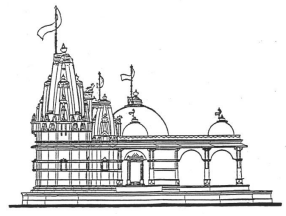
Figure 6.7 Sectional drawing of atypical Jain temple.
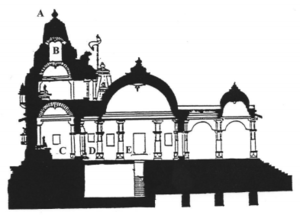
Key: A shikhara; B mandovara; C garbhagraha (sanctum); D pabaasana E antaraala (vestibule), F ranga mandapa; G open mandapa; H enclosed mandapa
Whilst Jain temples are often situated in towns and villages, where they serve as places of worship for the local community, many others are located at places associated with events in the lives of the twenty-four jinas or having other sacred associations. Often the sacred location, or tirtha, is at mountain or hilltop, frequently located in an area of wild and secluded natural beauty. From the medieval period at least, pilgrimage to these places has been an important feature of Jain piety. On some of these holy hills veritable temple cities have been erected containing hundreds of temples and smaller shrines, not built to any master plan but constructed wherever a level or potentially level space presented itself. With few exceptions, the temples as they stand today date from the fifteenth century CE or later and most of the earlier ones have been reconstructed. Strong walls surround these aggregate of temples, and the inner tuk or courts, within which groups of shrines stand, are a precaution against vandalism and destruction, perhaps, in earlier troubled times.
One of the most famous temple cities is Satrunjay, south of Palitana in Gujarat, the place where the first jina achieved liberation. The ridges of the two hills, two thousand feet above sea level, have more than 3,300 temples and shrines of varying design and size. Sri Adinatha temple, a particularly ornate building dating from 1530 CE, but situated on the site of a very much earlier temple, occupies the holiest part of the site (Vaid P.1980: p.2.428).
Plate 6.5 Aerial view of temple complex at Satrunjay, Gujarat

There is a fine caumukha temple dedicated to Risabhdeva, built in 1618 CE also on the site of an earlier structure. The eastern entrance to the (vimana) sanctuary, leads off the main hall, whilst the other three open through elegant two-storied porches, into the courtyard. About a hundred miles away to the west, near the town of Junagadh, stands the notable collection of temples at Girnar. They are not so numerous as those at Satrunjay but at least one, dedicated to Neminatha, the twenty-second tirthankara, dates back to before the thirteenth century CE (Vaid 1980: p.2.400).
Very interesting and unusual is the Vastupala temple. An inscription claims that the wealthy ministers Vastupala and his brother Tejapala had numerous temples erected. The Vastupala temple is unusual in having a central shrine leading from the east side of the main hall, dedicated to Mallinatha, whilst two further shrines on the north and the south sides of the hall contain a massive representation of the sacred mountains Sumeru and Sammeta Sikhara.
Although the temples of Girnar, Satrunjay and Mount Abu follow the style of the northern or 'nagara' temples of the Hindus, they are built of marble, which the wealthy Jain merchants, who funded many of them, were able to afford (Vaid 1980: 400, 428-32, 324-26). Moreover, it was usual to establish a board of trustees to maintain the temples to ensure that they are kept in particularly good repair. Mount Abu, just on the Rajasthan side of the boundary with Gujarat, about eighty miles west of Udaipur, is noted for the famous Delwara temples. The brothers Vastupala and Tejapala mentioned above founded one of the largest temples there. The temple has a large outer hall (rangamandapa). To keep a wide space clear of pillars the low dome has pushed the technique for constructing such a structure to extremes, with overlapping stone slabs and means of support which has allowed the structure to stand for many centuries, and which is something of a puzzle to modern architects. Mount Abu was already the site of a temple erected two hundred years earlier by Vimala Shah, a minister of the king of Gujarat. It is said that he built it as a penance for the bloodshed when he was sent as a military commander to quell a rebellion (Vaid 1980: p.326). The outstanding feature of the Mount Abu temples is the extraordinary intricacy of the almost transparent marble carving. Practically every surface and every structural detail is covered with figures and delicate tracery. The architecture and decoration of this temple is so outstanding that some consider it to be the eighth wonder of the world.
Plate 6 6 Interior of the Delwara temple, Rajasthan
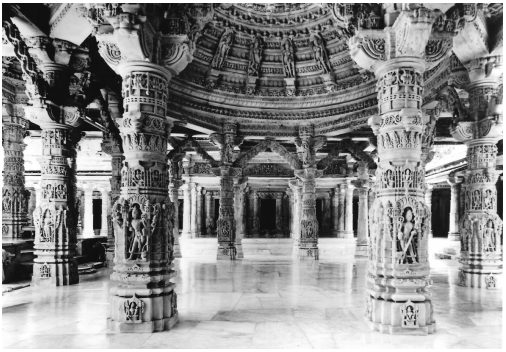
The installation ceremony for the Jain Centre at Leicester, in the United Kingdom, took place in 1988. It is a unique institution, a symbol of Jain unity, and provides a place of worship and study for all sects of Jainism. It has forty-four hand-carved pillars, a dome and ceilings, mirrored walls, stained glass windows, intricately designed mosaics made with numerous coloured pieces of glass for the smaller shrines, and for the first floor foyer, a marble frontage, a spacious hall, an auditorium, a library, a beautiful Jain educational museum and other facilities. It is an example of a unifying process, and has become a major tourist attraction in Leicester and a place of pilgrimage for Jains, perhaps due to some of its features being reminiscent of the intricate carvings of temples at Delwara and Ranakpur.
Plate 6.7 Jain Centre, Leicester, first place of worship for all major sects of Jainism showing the View of Svetambar and Digambar Temples Sthanakvasi Paat, Guru Gautam and Srimad Rajcandra mandeer.
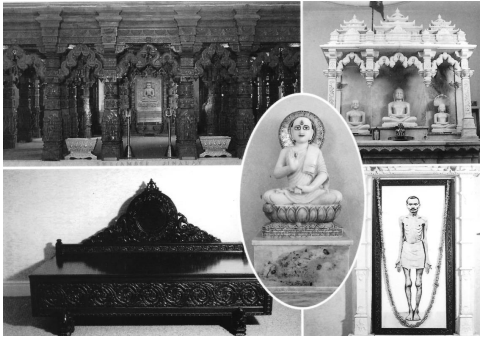
Jainism has made a considerable contribution to the architectural heritage of India, not only to the splendour of its great temple cities but also to countless other structures, great and small, throughout the length and breadth of the sub-continent. New temples, some of them very splendid, keeping to traditional forms, are still being erected, but unhappily there are old temples in areas where once Jains resided, which have fallen into decay. In a way, this demonstrates that the Jain temple is a vital living institution and not simply an artistic museum piece.
The temples of the great pilgrimage centres attract throngs of devotees. But the smaller less well-known temples are also centres for active religious life. It is right to beautify the edifice which houses the jina image, as a sign of pious devotion and because a beautiful environment can instil an aura of religious worship. Some, it is true, prefer to worship in austere surroundings: they are, or should be, respected by those who prefer more elaborate outward forms. The object of Jain worship is not only confined within walls, but the temple, hallowed by the presence of the jina image and by the prayers of devotees, is the most important institution of the living faith of the Jains.
As a largely mercantile community the Jain laity sees nothing improper in wealth if properly applied and honestly acquired, indeed, Jain temples and charitable foundations demonstrate the legitimate utilisation of wealth.
Often depicted in Jain art and sculpture is the liberated soul, with form but no material substance and depicted as a simple outline or an empty mold, an absent cut-out figure from a metal sheet. The images of a Jain temple are rich, varied and beautiful. However, the simple figure of the jina is the prime focus of Jain worship. In spite of the austere simplicity of basic Jainism the worshipper's respect can nevertheless wander freely across the regions of the gods. But central to the worshipper's faith is belief in the jina, as an example to be followed, not as a donor of gifts or a judge of merit and demerit, still less as the awesome bearer of divine retribution. In the final analysis, the individual has no external gods to grant him or her liberation but the devotee must strive onward by individual effort and self-cultivation.
Jains do not worship a creator God, but meditate on the nature of the jina who has attained the ideals of enlightenment and final liberation. They meditate on this ideal as an example, do not ask any favours, and pay homage or worship with devotional gratefulness for the path shown to enlightenment. Jain worship is, not a worship of God or a deity, but of a human being who has reached perfection by liberating the soul from all bondage. It is the worship of the godhood, the attributes of the perfect human being or liberated soul that is remembered, adored and meditated as an ideal, not hero-worship. The idol or the image, therefore, serves more as a symbol or the attributes than as the portrait of a jina. In worshipping the image, the devotee remembers the qualities or virtues of the jina and tries to imbibe them into his or her own life. Strictly speaking, image worship is not absolutely necessary for the attainment of emancipation; it is the psychic worship, not physical or ritualistic worship that really matters. But it is obvious that worship of an image has been found to be much needed in the initial stages, until one develops the spiritually advanced mental attitude. Hence, purposeful temple rituals for worship have been developed and have been described in the Jain scriptures and literature (see chapters 5.2, 5.3, 5.4). Worship, physical and psychic, has been integral to the daily routine of a Jain, so that the worshipper can keep the ideal of liberation as the goal of life.
The rituals, the ceremonies, the formal prayers and hymns lead the faithful onwards to spiritual development, but these are not the final stages of a spiritual training. Beyond a certain stage, the Jain will find that he or she has less and less need of external aids to devotion and worship, and will reach that higher level where the jina is present as an abstraction, not in a physical image. This stage is not, yet, for everyone and the temple and its worship are there to help the aspirant on the path to liberation.
Places of pilgrimage
Jain places of pilgrimage are found in almost all parts of India and the sites of the 'sacred geography' are referred to by Svetambars as yatra-dhaamas (place of pilgrimage) and by Digambars as tirtha-ksetras (region of pilgrimage). Jain places of pilgrimage are associated with the auspicious events (kalyaanakas) in the lives of tirthankaras and their liberation, or other saints (siddhaksetras), miracles, myths (atisayksetras), and monuments, temples and images (kalaaksetras); and, often, all of the above characteristics may be present at one site.
Table 6.7 lists important places of pilgrimage, but there are of course many more places throughout India. Pilgrims travel to these sites either by vehicles or on foot, but, over the past decade, the old tradition of sangha-yatra, walking to a pilgrimage destination, has been revived and proved very popular, as it trains pilgrims for the spiritual life and is beneficial to the community.
Table 6.7 Important places of pilgrimage and their significance.
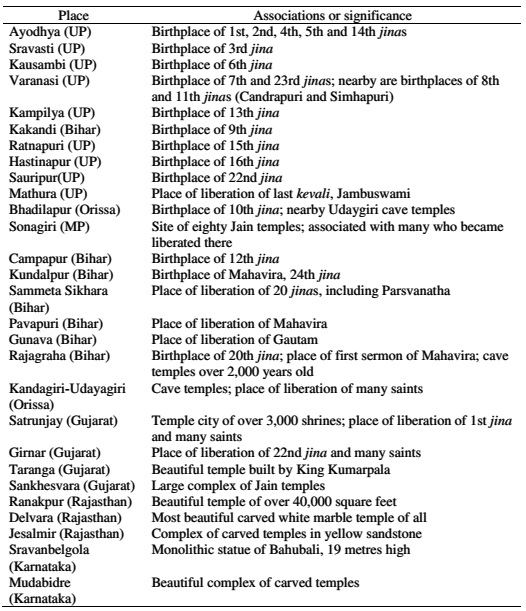
 Dr. Natubhai Shah
Dr. Natubhai Shah
